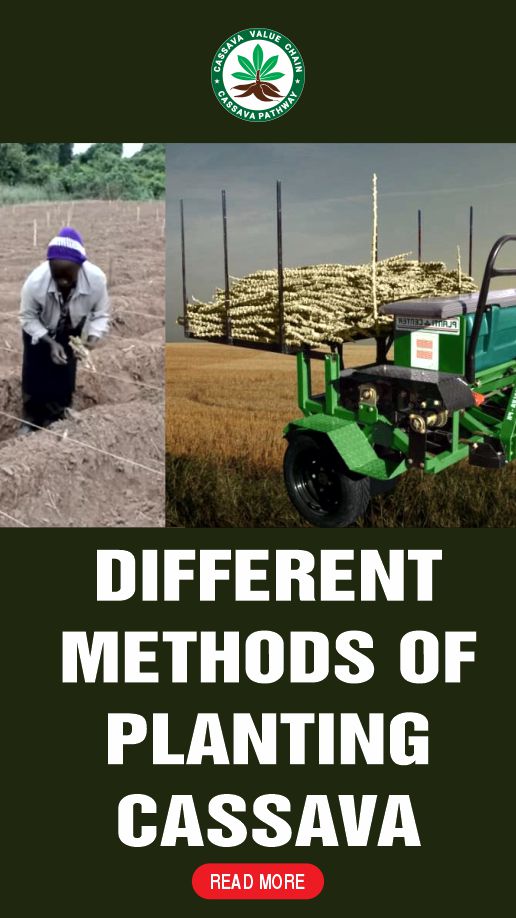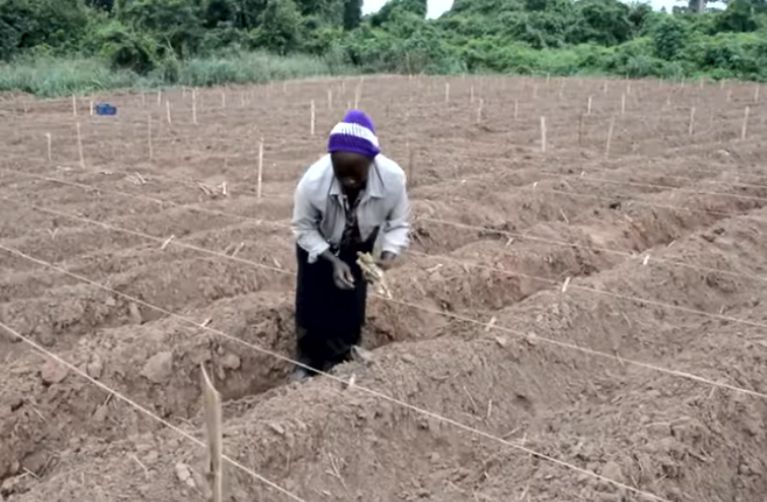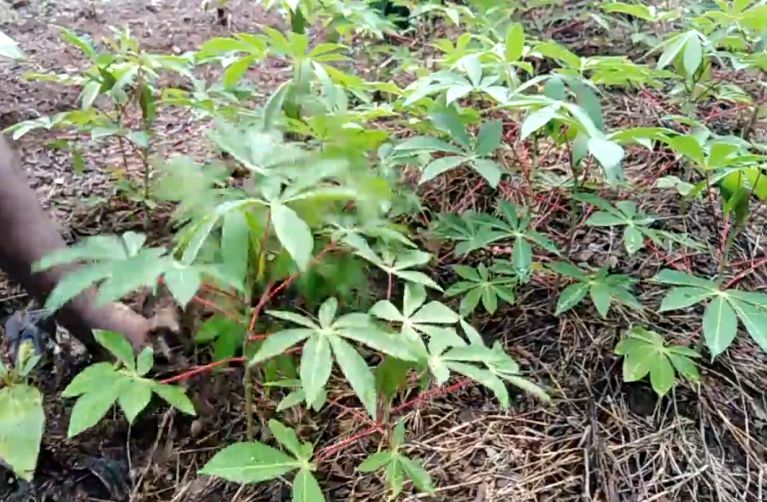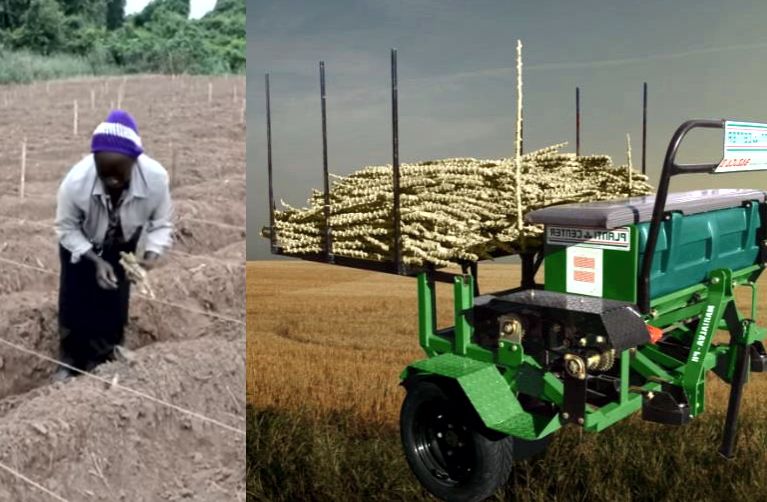Understand the different cassava planting methods, from traditional stem cuttings to modern techniques. Learn how to choose the best method for maximum yield, sustainability, and resilience in your farming practices.
When it comes to cassava planting methods, selecting the right approach is important for a bounty harvest.
Traditional methods, such as planting cassava stem cuttings, have long been a staple in agriculture due to their cost-effectiveness and simplicity.
However, as farming technology advances, modern methods such as mechanization and the use of improved cassava varieties are gaining popularity.
These techniques promise enhanced efficiency, better disease management, and higher yields.
Choosing the most suitable cassava planting method depends on various factors, including soil type, climate conditions, and farm size.
This guide discusses the different methods available, helping you as a cassava farmer make informed decisions that align with both your immediate needs and long-term goals for sustainable farming and increased profitability.
If you are new to the cassava supercrop, here is a good place to start.
Related: How to Cut Cassava Stems the Right Way

Table of Contents
- The Cassava Planting Methods
- The Traditional Method: Stem Cuttings
- Mechanized Method of Planting Cassava: An Overview
- Whole Stem Planting Method
- Direct Seedling Method: A Simple Approach
- Nursery and Transplanting: A Comprehensive Guide
- Factors Influencing the Choice of Cassava Planting Method
- Choosing the Right Method for Your Farm
- Modern vs Traditional Planting Methods
- Frequently Asked Questions
- Conclusion
The Cassava Planting Methods
When it comes to planting cassava, different methods can suit various farm sizes and conditions. Each technique has its benefits and challenges. Here are the main methods of planting cassava that you can consider for your farm:
- Traditional method
- Whole stem method
- Mechanized method
- Direct seedling method
- Nursery and transplanting method
Related: How to Peel Cassava without Wastage
The Traditional Method: Stem Cuttings

Planting cassava using mature stem cuttings is the oldest and most common method. It’s easy to implement, especially for small- and medium-scale farmers.
The process involves selecting healthy, mature cassava stems, typically one to two years old, to ensure they have viable buds for growth. See how to plant cassava cuttings.
This encourages the cuttings to sprout and grow into strong, healthy plants. It’s a reliable method that maintains the same qualities as the parent plant, keeping the cassava’s genetic traits consistent.
While the method is affordable and simple, it does come with some challenges. The labor required for preparing and planting the stem cuttings can be time-consuming.
Plus, there’s the risk of disease if the cuttings aren’t sourced properly, which could lead to crop losses.
Despite these drawbacks, many farmers still use this method, especially where resources are limited. It’s a tried-and-true approach that has sustained cassava cultivation for generations.
Related: How to Fertilize Cassava Plants
Why This Method Still Works
Even though new techniques are emerging, the stem-cutting method remains popular for good reasons.
It’s accessible, low-cost, and has stood the test of time.
However, to maximize your success with this method, pay attention to stem selection, planting depth, and spacing to minimize disease risks and ensure optimal growth.
Choosing the right cassava planting method depends on your specific farm conditions, so weigh the benefits and challenges of each option before deciding.
Pros and Cons
Pros
- Low cost: It’s an affordable method, especially for farmers with limited resources.
- Simplicity: Easy to implement with minimal technical knowledge.
- Reliable: Maintains genetic continuity, ensuring the cassava plant’s qualities are consistent.
Cons
- Labor-intensive: Preparing and planting stem cuttings can be time-consuming and require a significant amount of work.
- Disease risk: If the cuttings are sourced from infected plants, there’s a higher risk of disease, which could result in crop loss.
Related: What is the Standard Intra-Row and Inter-Row Spacing for Cassava?
Mechanized Method of Planting Cassava: An Overview

The mechanized method of planting cassava involves using specialized equipment to automate the planting process.
This approach is particularly beneficial for large-scale commercial farms that aim to increase efficiency and reduce labor costs.
Machinery such as precision planters, seeders, and tractors are used to plant cassava stem cuttings at specific depths and spacings, optimizing growth potential.
Mechanized planting can significantly boost productivity, speed up planting, and reduce human error.
However, it also requires a certain level of infrastructure, investment, and expertise.
Pros of Mechanized Cassava Planting
- Increased Efficiency: Mechanized planting drastically reduces the time required for planting, making it ideal for large-scale farms.
- Labor Cost Reduction: With machinery taking over the planting process, the need for manual labor is minimized, cutting down on labor costs.
- Precision: Machines ensure uniform depth and spacing of stem cuttings, which promotes consistent growth and improves overall crop yields.
- Scalability: This method allows for the planting of large areas in a shorter time, making it ideal for large-scale cassava production.
- Improved Productivity: By speeding up the planting process, mechanized methods allow farmers to allocate more time for other critical aspects of farm management, leading to overall improved farm productivity.
- Better Land Use: It ensures efficient use of land, as machines can easily navigate large fields without damaging the soil.
Related: Cassava Weed Management Strategies
Cons of Mechanized Cassava Planting
- High Initial Investment: The cost of purchasing and maintaining planting machinery can be prohibitively expensive, especially for smallholder farmers.
- Infrastructure Requirements: Mechanized planting requires a certain level of infrastructure, such as wide, clear paths for machinery to move through, which may not be available in all regions.
- Not Suitable for Small Farms: Due to the high costs and specialized equipment required, mechanized planting is more suitable for large-scale commercial farms and may not be feasible for smallholder operations.
- Dependence on Machinery: In areas where machinery breakdowns or maintenance issues occur, delays in planting can negatively affect the timing and success of the crop.
- Environmental Concerns: Excessive use of machinery can lead to soil compaction, reducing soil health over time and potentially affecting long-term sustainability.
- Skill Requirements: Operating and maintaining the machinery requires specific skills and training, which might be a barrier in areas with limited access to agricultural education.
Related: Guide to the Cassava Hybrid
Whole Stem Planting Method
Whole stem planting involves planting entire cassava stems instead of cutting them into pieces.
This method is straightforward and can help boost growth and yield. When you plant whole stems, they tend to sprout multiple shoots, which leads to faster growth.
This rapid development can result in higher yields, making it a solid choice for both small and large-scale cassava farmers.
Why Whole Stem Planting Works
Whole-stem planting encourages vigorous growth. By using the entire stem, you create an environment where multiple shoots can sprout from each planting, leading to faster development and a healthier plant system.
The stem’s length also provides a better foundation for stronger root growth. This leads to a plant that’s better able to tap into nutrients in the soil and resist challenges like drought or pest pressure.
Pros of Whole Stem Planting
- Faster growth: The whole stem sprouts multiple shoots, leading to quicker development.
- Higher yields: Vigorous growth can boost your harvest, benefiting both smallholder and commercial farms.
- Stronger root development: The stem’s length encourages better root establishment, making the plant more resilient to pests and drought.
Cons of Whole Stem Planting
- Requires more space: Whole stems need to be spaced out properly. Overcrowding can affect growth and reduce yields.
- Need for precision: If the stems aren’t planted at the right depth or orientation, it can affect sprouting and plant productivity.
Whole-stem planting can be an effective method for higher yields and faster growth, but it’s important to manage space and plant with care to maximize the benefits.
Related: Signs Cassava is Ready to be Harvested
Direct Seedling Method: A Simple Approach
The direct seedling method is a straightforward way to grow cassava by planting seeds directly in the soil, rather than using stem cuttings.
Though less common than traditional methods, this approach can be a game-changer in certain situations.
It’s particularly useful when cassava cuttings are hard to come by or if you’re working in regions where planting materials are scarce.
Why Direct Seedling Method Works
This method can be highly effective, especially when you focus on timing and environmental conditions.
Ideal soil should be well-prepared, moisture-retaining, and free of weeds. Also, choosing the right cassava seed variety that adapts well to local conditions is key.
Pros of the Direct Seedling Method
- Cost-effective: No need for nurseries or cuttings, which lowers expenses for small-scale farmers.
- Less labor-intensive: It saves on labor by simplifying the planting process and reducing resource needs.
- Faster planting: Quicker to implement compared to more complex methods, enabling faster establishment of crops.
Cons of Direct Seedling Method
- Vulnerable seedlings: Young plants are more susceptible to pests and environmental stress.
- Need for careful management: Seedlings require close attention, including watering and protection from threats, to ensure healthy growth.
While the direct seedling method is simple and economical, it requires attention to detail and the right conditions to thrive.
With the right approach, it can be a viable and productive option for cassava farming.
Related: How to Grow Cassava in Small Spaces
Nursery and Transplanting: A Comprehensive Guide

Starting cassava in a nursery can help you ensure strong and healthy plants before transplanting them into the field.
By creating a controlled environment for your seedlings, you can control growth factors like moisture, temperature, and nutrients, giving your plants the best start.
This method helps reduce pests and diseases and results in a more uniform crop that’s ready for earlier harvesting.
Why Nursery and Transplanting Works
By using a nursery, you can carefully manage the early growth stages of cassava. The controlled setting leads to stronger seedlings, which are more resilient when moved to the field.
Plus, transplanting at the right time boosts overall productivity and ensures your cassava plants grow well from the start.
Pros of Nursery and Transplanting
- Uniform growth: Starting plants in a nursery means they grow under optimal conditions, leading to healthier, more consistent crops.
- Early harvesting: Healthy seedlings are ready to be transplanted earlier, reducing the long wait for cassava to mature.
- Optimized planting time: You can transplant when field conditions are best, using resources efficiently and improving the success rate.
Cons of Nursery and Transplanting
- Requires space: Setting up a nursery needs additional land and time before transplanting.
- Initial investment: The infrastructure and resources needed for a nursery can be costly and may not be practical for all farmers.
- Time-consuming: Seedlings take several weeks to develop in the nursery, which may delay the planting process.
In the end, the nursery and transplanting method offers clear benefits, especially for those seeking early harvesting and consistent plant growth.
But, it does come with additional space and time requirements that you should consider before choosing this approach.
Related: The 6 Best Practices in Cassava Farming
Factors Influencing the Choice of Cassava Planting Method
Choosing the right cassava planting method isn’t a one-size-fits-all decision. Several factors can impact your success, from climate conditions to farm size.
Understanding these factors can help you select the most effective approach for your specific situation.
1. Climate and Weather Conditions
Cassava grows best in tropical climates with consistent rainfall, typically between 800 to 1,200 millimeters annually.
In regions where drought is common, you may want to focus on planting methods that conserve soil moisture.
On the other hand, if your area experiences heavy rainfall, ensuring proper drainage will prevent root rot.
2. Soil Type and Fertility
While cassava can adapt to different soil types, it grows best in loamy, well-drained soil rich in organic matter.
Poor soil quality can affect the growth rate and yield. Soil testing is key to understanding nutrient levels and deciding whether you need soil amendments to support better root development.
3. Farm Size
Your farm size will influence the method you choose. Larger farms can benefit from mechanized planting methods that save time and labor, while smallholder farms may rely on manual techniques.
Consider the trade-off between labor intensity and time efficiency when making your decision.
4. Labor and Time Constraints
If labor costs are high or you’re short on time, you may prefer planting methods that require less work and can be implemented quickly.
For example, some methods are more labor-intensive but cheaper, while others are faster but come with higher costs.
Choosing the best cassava planting method is a balancing act. By considering your local conditions, farm size, and available resources, you can select the method that works best for you, leading to a more successful harvest.
Choosing the Right Method for Your Farm
Selecting the right cassava planting method depends on various factors. Each farm is different, so understanding what works best for your specific situation will help you achieve better yields and a healthier crop.
1. Climate and Temperature
Cassava thrives in warm temperatures between 24 to 30 degrees Celsius. If you farm in a cooler region, you may need to consider protected planting methods or choose cold-tolerant varieties.
Pay attention to rainfall patterns too, as cassava needs well-distributed rainfall to grow properly.
2. Soil Conditions
Cassava grows best in well-drained, organic-rich soils. Sandy loam soils are ideal for deep root growth, making harvesting easier.
If your soil is heavy or compacted, consider raised beds or other methods to improve drainage and root penetration.
A soil test will help you determine if you need to amend your soil before planting.
3. Resources Available
Consider what resources are accessible to you. For example, do you have reliable access to quality stem cuttings?
You may need to either propagate your own or purchase from trusted suppliers. Also, assess the labor and equipment required for different planting methods.
Small-scale farmers may find traditional methods more affordable, while large farms could benefit from mechanized methods that reduce labor costs.
4. Technological Options
Think about the technology you have available. Advances like precision agriculture tools and planting machinery can increase efficiency and boost yields.
If you have access to these tools, they can help optimize your planting method.
By carefully considering these factors, climate, soil, resources, and technology, you’ll be able to choose the planting method that best fits your farm’s needs and boosts your cassava production.
Recommended: Best Time to Plant Cassava According to Regions
Modern vs Traditional Planting Methods
Cassava farming has come a long way, with traditional and modern planting methods each offering unique benefits.
The right choice depends on your specific circumstances, resources, and farming goals.
Traditional Planting Methods
Traditional planting methods have been passed down through generations and are still widely used in small-scale farming.
These methods mainly involve using mature cassava stems that are cut and planted directly into the soil.
This approach is simple, affordable, and well-suited for farms with limited resources.
Traditional methods also often leverage local knowledge of soil health and pest control, which can help optimize yields in specific environments.
Modern Planting Methods
Modern methods incorporate the latest agricultural technologies. These techniques use improved cassava varieties that are more resistant to pests and diseases and better suited to different soil types.
Modern practices also include precision planting, where stem cuttings are carefully spaced and placed at the right depth to encourage better growth.
This method can lead to higher yields and is typically preferred in large-scale commercial farming operations aiming for efficiency and increased profitability.
Choosing the Right Method for Your Farm
Your choice between traditional and modern planting methods depends on a few key factors.
Traditional methods are often best for subsistence farmers or those with fewer resources.
On the other hand, modern methods work well for larger farms that need to scale up production and maximize efficiency.
Other factors like soil type, climate, and market demand also influence the decision.
Ultimately, the method that works best for you will depend on your farm’s specific needs and goals.
Frequently Asked Questions
What is the best method to plant cassava for high yields?
The best method depends on your farm size, soil type, and resources—mechanized methods boost yield on large farms efficiently.
Can I plant cassava directly from seeds instead of stem cuttings?
Yes, but direct seeding is less common. It requires careful management and ideal conditions for seedlings to thrive and grow successfully.
Why is mechanized cassava planting not suitable for all farms?
It’s expensive and requires infrastructure. Small farms may lack space, machinery access, and training needed for proper machine operation.
How do I choose the right cassava planting method for my farm?
Consider climate, soil, labor, and budget. Match your method to these conditions to ensure sustainability and maximum crop performance.
Conclusion
In conclusion, selecting the right cassava planting method is crucial for maximizing productivity and sustainability.
Each method, from traditional stem cuttings to modern techniques, offers unique benefits and challenges depending on your farm’s conditions.
Trial runs and consulting with local experts can help determine the best fit for your situation.
Successful cassava cultivation goes beyond planting techniques, requiring effective management practices like fertilization and pest control.
By continually optimizing both methods and management, farmers can achieve higher yields, and healthier crops, and contribute to food security and local economies.
The key is ongoing learning and adaptation to ensure long-term success.

Chimeremeze Emeh is a writer and researcher passionate about Africa’s most transformative root crop—cassava. Through his work at cassavavaluechain.com, he explores the entire cassava industry, from cultivation and processing to its diverse applications in food, health, and industrial use.
He also writes for palmoilpalm.com, where he shares his extensive experience and deep-rooted knowledge of palm oil, covering red palm oil, palm kernel oil, and refined products. His work there reflects his lifelong connection to agriculture and his commitment to promoting sustainable value chains in Africa.
Driven by curiosity and purpose, Chimeremeze aims to shed light on how cassava continues to empower communities, strengthen food systems, and link traditional farming wisdom with modern innovation.

